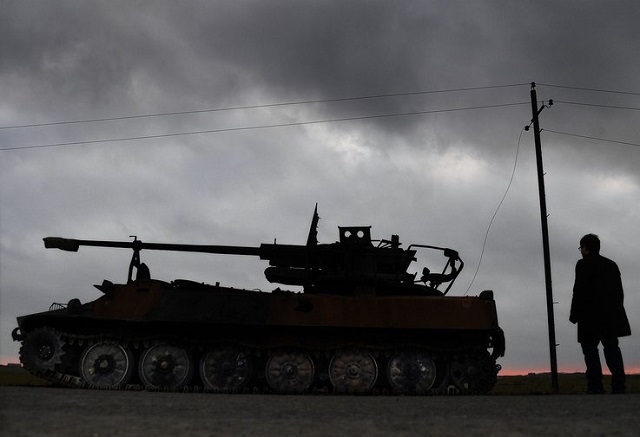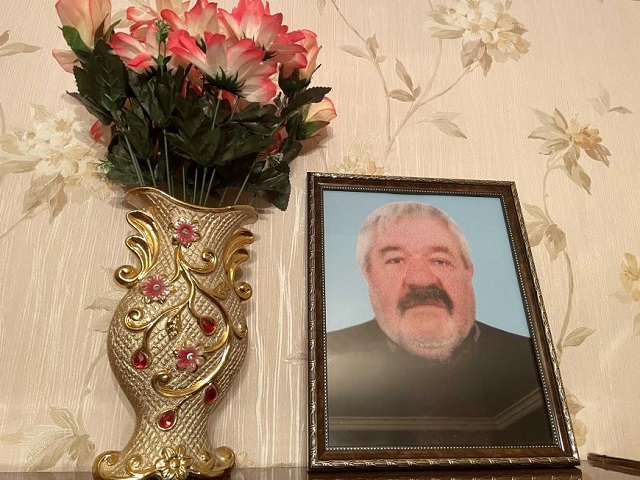New evidence of torture and inhumane treatment of civilians by Azerbaijani forces emerges
During last autumn’s six-week war between Armenia and Azerbaijan over the ethnic-Armenian majority enclave Nagorno-Karabakh, as Azerbaijani forces took control of areas in and around the region, they rounded up local civilians. Most younger civilians had fled the hostilities. Those remaining, with few exceptions, were older people who did not want to abandon their homes.
Human Rights Watch (HRW) documented several cases in which Azerbaijani forces used violence to detain civilians and subjected them to torture and inhuman and degrading conditions of detention. Two detainees died in Azerbaijani captivity; one of them, based on the evidence, was most likely the victim of an extrajudicial execution. Azerbaijani forces detained these civilians even though there was no evidence that they posed any security threat – they had no weapons and did not participate in the hostilities.
Read also
Here are the stories of the two detainees who were killed, via accounts from their close relatives who were taken into custody with them and also subjected to torture and cruel, inhuman and degrading treatment. To document these crimes, we interviewed two people who had been held in captivity and their family members, examined photo and video evidence provided by both the families and Armenia’s Representative Office at the European Court of Human Rights (ECHR), reviewed medical documents, and spoke with lawyers representing the families.
Claims about Continued Captivity
The fighting began on 27 September and ended on 10 November, 2020, with a Russia-brokered peace agreement. The agreement provided, among other things, for “an exchange of prisoners of war and other detained persons and bodies of the dead.”
By the end of February, Armenia’s Representative Office at the ECHR had asked the court to intervene with the Azerbaijani authorities regarding 240 alleged prisoners of war (POWs) and civilian detainees. In approximately 90 percent of those cases, the office said, they had photo and/or video evidence confirming that these people were in Azerbaijani custody; in the rest of the cases, they relied on witness accounts. HRW is not in a position to determine the exact number of civilians detained by Azerbaijani forces. Two leading human rights lawyers working on the issue estimated that more than 10 percent of those detained by Azerbaijani forces were civilians.

Azerbaijani military equipment near Fizuli, December 2020 | (c) Aleksandr Kazakov/Kommersant/Sipa USA. All rights reserved
More than three months after the truce, Azerbaijan has returned a total of 69 Armenian Prisoners of War (POWs) and civilians. An Armenian foreign ministry representative told HRW that they believe more than a dozen civilians are still in Azerbaijani custody. Their families are increasingly distraught, especially in light of the abundance of graphic videos of abuse of prisoners circulating on social media, and the horrendous accounts of some of those who have been repatriated.
International Law and the Treatment of Civilians During Armed Conflict
Under the Fourth Geneva Convention, which sets out protections for civilians in an international armed conflict such as that between Armenia and Azerbaijan, civilians are “protected persons.” The convention requires that anyone “taking no active part in the hostilities, […] shall in all circumstances be treated humanely, without any adverse distinction founded on race, colour, religion or faith, sex, birth or wealth, or any other similar criteria.” During hostilities, it permits the internment or assigned residence of protected persons such as civilians where it is absolutely necessary for the security of the detaining power, or, as the International Criminal Tribunal for the former Yugoslavia has put it, there are “serious and legitimate reasons” to think the interned persons may seriously prejudice the security of the detaining power. However, unlawful confinement of a protected person is a grave breach of the Geneva Conventions; in other words, treated as a war crime.
Also, as a state party to the International Covenant on Civil and Political Rights and the European Convention on Human Rights, Azerbaijan is bound by prohibitions on arbitrary detention as well as on torture and other degrading or inhuman treatment.
The wilful killing and ill-treatment of protected persons that we document below constitute war crimes under international humanitarian law. Azerbaijani authorities should, without further delay, investigate the credible allegations regarding the unlawful detention of these civilians, their inhuman and degrading treatment, and the possible extrajudicial execution of a detainee, with a view to holding all perpetrators to account. They should also promptly free and repatriate any and all civilians who remain in their custody.
Arega and Eduard
Arega Shahkeldyan, 72, is huddled in a large armchair by the window in a small rented apartment in Stepanakert, the capital of Nagorno-Karabakh, which is slowly recovering from the war. Her family, like many others, fled to the city when Azerbaijani forces were advancing and ultimately regaining control over a large part of Nagorno-Karabakh and the surrounding regions.
The family are destitute, having lost their home and belongings. Their future is uncertain. But this is not what Arega is thinking of. She is mourning her husband of many years, Eduard. At the end of October, Azerbaijani forces detained both of them in their home in the village of Avetaranots, in Askeran district of Nagorno-Karabakh, and took them to a prison in Baku, Azerbaijan’s capital. Arega returned home after six weeks. Eduard, 79, died in prison under unclear circumstances.
Soon after hostilities began on 27 September, most residents left the village, but Arega and Eduard remained behind. Their children made several attempts to take them to Stepanakert, but Eduard flatly refused, arguing that Azerbaijani forces had never entered the village during the first war, 30 years ago, couldn’t possibly now, and that there was no way he would abandon his home and possessions.
On the morning of 28 October, their daughter Gokhar called them at 9 am to ask how the night had been and saying that she and her husband would come to the village later in the day to collect them, whether they wanted to leave or not – it was getting too dangerous. Eduard said everything was OK. But he had no idea that Azerbaijani forces had already entered the village. Fifteen minutes later, Gokhar’s husband, Vladik, called again to urge them to pack, but a stranger picked up the phone, speaking in Azeri. “Who are you?” Vladik asked in the same language. “I’m Azerbaijani and this is Azerbaijan,” the man said. The phone went dead.
“Their soldiers just ran into the house with those big automatic rifles, pointing their weapons at us, shouting, threatening,” Arega said. “I started crying, pleading with them not to hurt us, but they twisted my husband’s arms behind his back and led him out of the house. Then they pounced on me, I screamed, I tried to resist, I was telling them I won’t go anywhere, but they were yelling and pushing me, so they forced me out. I begged them to at least let me take some warm clothing, but they did not.”
Azerbaijani soldiers took Arega and Eduard to a house higher up in the village, whose owner had fled, and kept them there for the night with two other local residents: Sedrak, a nearly blind neighbor in his seventies, and Baghdasar, another neighbor about ten years younger. In the morning, the soldiers took the four detainees to another abandoned house in the village and put them in a shed. At night, Baghdasar managed to dislodge one of the stones from the shed’s wall and escaped through the hole. The other three didn’t have the strength to attempt it.
“We spent all night in that shed, with no food, no water. It got cold and I was shivering in my thin gown. My husband and Sedrak dozed off at some point, but I couldn’t sleep. I was too scared. I just sat there shivering and crying.”
The next day, the soldiers took the detainees to a logging site in the mountains nearby. “More soldiers were there and one of them punched Eduard several times and kicked him with booted feet, yelling that he had surely taken part in the war 30 years earlier and this was his punishment for killing Azerbaijani people back then.” Another soldier, hearing Arega scream as she watched her husband being beaten, tried to reassure her: “Don’t be afraid, Granny, it’s going to be OK. You’re old. No one will kill you. Just bear up – and after a while, you’ll be released.”
The detainees were forced to climb onto the back of a truck, on top of logs, and travelled for hours. No one told them where they were going. They were hungry, thirsty, cold, and frightened. Late that night, the truck arrived in Baku. Their captors locked them in a room in what seemed like a private house, without letting them use the bathroom or giving them any food or water.
In the morning, men in military uniforms blindfolded them, put them in a vehicle and took them to what their family later learned was SIZO-1, the pretrial detention facility in the settlement of Kurdakhany in Baku. On arrival in the prison yard, the guards untied the blindfolds and allowed the detainees to drink water from a tap. They briefly saw another civilian from their village, Maxim Grigoryan, “a younger man” who later disappeared.
His family still has no information as to his fate and whereabouts, Gokhar sighs.
Those few minutes in the yard were the last time Arega saw her husband alive. Shortly after their arrival, the guards took Arega to a cell already occupied by another older woman, Azniv.
In early November Gokhar heard from the International Committee of the Red Cross (ICRC) that her parents were in prison in Baku. When the hostilities ended, on 10 November, the family thought they would be sent back soon. On 5 December, a man called Vladik, Gokhar’s husband from an Azerbaijani number and said, in Azeri-accented Russian, that he would put Arega on the line. Gokhar snatched the phone: “Mamma, are you already here? They brought you back?” But her mother was crying and mumbling incoherently.
“Mamma, please pass the phone to Daddy!” Arega started sobbing uncontrollably, then the line went dead. Three minutes later, the unknown man called again from the same number saying, “Your mother was trying to tell you that your father died. I’m sorry.”
That morning, before the phone call, the guards had opened the door of Arega’s cell and told her that Eduard had died in his sleep and they were there to take her to his cell, so that she could view the body. She was in a state of shock and does not remember much about those awful moments, except that her husband’s face was black and blue. Sedrak and another cellmate also told her that Eduard had gone to sleep and did not wake.
Eduard’s family pointed out that he had asthma for many years and had to take medication three times a day. In detention, he no longer had access to his medications. “Mamma had a stroke years ago and suffers from high blood pressure, so she had to take prescription medicine every day,” Gokhar says. “But in prison, they would not give it to her, and no doctor examined her, despite her requests. It must have been the same for Daddy, and the stress of the captivity also took its toll.”
On 9 December, the Azerbaijani authorities returned Arega and several other detainees to Armenia. Eduard’s body was also supposed to be returned on the same flight. However, the next day when the family saw the body that had been on the flight, they realized it was another man, younger, with a scar on his face. At first, the Azerbaijani authorities denied they had sent the wrong body. Finally, on 28 December, they shipped Eduard’s body to Yerevan, Armenia’s capital, and the family buried him. On his death certificate, issued by the Armenian authorities following an autopsy, the cause of death is listed as blunt brain injury, brain swelling, and acute disorder of vital brain function.
Clutching her hands, Auntie Arega stared from beneath her black mourning kerchief. “At least, they finally returned his body,” she says. “And I now have a grave to visit.”
Sasha and Arsen
On 7 October, the women and children of the Gharakhanyan family fled Hadrut, a city in Nagorno-Karabakh. The Azerbaijani army was advancing, and it no longer felt safe to remain. But 71-year-old Sasha Gharakhanyan would not hear of leaving his home. Sasha’s 44-year-old son, Arsen, who had lived in Moscow for several years but came to visit his parents shortly before hostilities began, could not bear to leave his father all alone. So, he also stayed.
On 10 October, Arsen was in the center of Hadrut when he saw the first Azerbaijani soldiers in the city. He rushed home to collect his father, hoping there was still time for the two of them to flee. But when he entered the house, it was already full of Azerbaijani soldiers, at least 15 of them. His father watched helplessly as they pounced on Arsen, tied his hands behind his back, and led him away.
Arsen’s sister Marine had last spoken to her father and brother on 9 October. When their phones stopped working a day later, she and the rest of the family feared the worst. On 9 November, they had the first glimpse of hope: a video began circulating on social media with Azerbaijani soldiers forcing Sasha to kiss the Azeri flag and repeat “Karabakh – Azerbaijan.” At least he was alive. Ten days later, the ICRC told the family that their representatives had been able to locate and visit Sasha in a prison in Baku, where he was being held in a cell with five other civilians.
On 14 December, Azerbaijan returned Sasha to Armenia as part of a group of 44 POWs and civilians. He spent the next ten days in hospital. Sasha’s wrists and ankles were deeply scarred from having been tightly bound with wire. There were also scars on the back of his head where a soldier hit him several times with a rifle butt, and scars on his back from being poked with a metal rod. X-rays showed that one of his ribs on the left had been fractured and that he had a broken nose. Sasha was weak and disoriented and kept asking for his son. But there was no news of Arsen.
Once Sasha was discharged from hospital, his family took him to Stepanakert, where the six of them still share a tiny two-room apartment with one large bed and one sofa, temporary accommodation provided by the local authorities. On 6 January, after almost three months of having no information about Arsen’s fate, the family saw a video circulating on social media. It showed Azerbaijani soldiers forcing Arsen to say “Karabakh is Azerbaijan” and to call Nicol Pashinyan, Armenia’s Prime Minister, degrading names. Arsen looked worn out but he didn’t seem to be wounded or visibly hurt.
“The day that video suddenly popped up was actually my birthday,” says Aida, Arsen’s mother, her eyes swimming in tears. “It was such an amazing gift to learn that my son was alive. We began waiting for him to return, like his father did. We even bought him new clothes.” On 8 January, another video appeared on social media, with Azerbaijani soldiers mocking Arsen and ordering him to “say hello to Shusha” (‘Shushi’ in Armenian, a town taken by Azerbaijani forces in a decisive victory in early November). The second video only reinforced the family’s hopes.
On 13 January, in response to an Armenian government request, the ECHR asked Azerbaijan to provide information about Arsen’s fate and whereabouts. Five days later, in the course of the search for dead bodies in Hadrut region, with the mediation of Russian peacekeepers and the ICRC, Arsen’s body was found near the village of Aygestan. From the photos we were shown, the grave appeared to be fresh, and the body showed no obvious signs of decomposition. There were clear marks of gunshots through the forehead and chin. The conclusion of the Armenian medical examiners was that Arsen had been shot dead on 15 January, two days after the European Court raised his case with the Azerbaijani government.
Sasha is too weak to sit through our conversation. He leans back on top of the meticulously made bed, detailing what happened on 10 October; how the soldiers took him to the centre of Hadrut, pushed him, kicked him, poked him with something sharp, tied him up, and threw him into the back of a truck, “like a log”. He describes how they threw stones at his legs, how the wire that tied his legs cut through his skin, and how his captors pulled him up by his bound legs and secured them to a rack on the back of the truck.
The scarring on one of his ankles is horrendous, as if the wire had cut through to the bone. His right hand is still swollen, and he has difficulty moving it. He speaks in monotone, grudgingly, without looking up. His wife, sitting next to him, on the edge of the bed, cannot stop crying: “Why did they kill our son? He wasn’t fighting in the war. He was unarmed. He just stayed to watch over his father. So, it’s a war, so they rounded him up – but the war ended, and they still didn’t let him go. They abused him, they filmed him, they posted those videos… and then killed him. Why?”
Tanya Lokshina
Main Photo Caption: Eduard Shahkeldyan | Source: HRW





















































